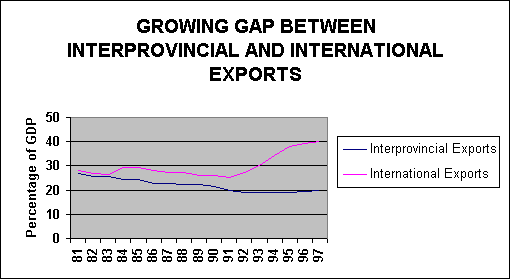GLOBAL ECONOMICS
GLOBAL ECONOMICS COMMENTARIES
Patrick Grady and Kathleen Macmillan
"Is North-South Killing East-West?"
Policy Options, June 1999, p.68.
Canada is becoming more and more of a trading nation. But while international trade accounts for a growing share of our economy, the share of interprovincial trade has shrunk.
Canada is much more dependent on foreign trade than the other G-7 countries - four times more than the United States and Japan, and two thirds more than Germany, France, Italy and the United Kingdom. And Canada's exports have mushroomed in the past two decades, growing from 28 percent of our Gross Domestic Product (GDP) in 1981 to over 40 percent in 1997, with the biggest leaps occurring after 1989 when the Canada-US Free Trade Agreement (FTA) came into effect.
Canada's other important trading relationship is an internal one. Trade between Canadian provinces accounted for 27 percent of GDP in 1981 - about on par with international trade. However, while international exports have catapulted since that time, trade between provinces has collapsed to the point that it accounted for only 20 percent of GDP in 1997.
Should these trends concern us, knowing how critical trade is to job creation and economic prosperity in this country? Do they signify a fatal fracturing of the Canadian market under the joint pressures of globalization and relentless federal - provincial bickering? Or, should we be content to reap the fruits of international trade liberalization begun under the FTA and continued under NAFTA and the WTO and view these figures in more sanguine terms?
The rumors of the death of our internal market are vastly exaggerated. Almost half of the growing gap between international and interprovincial exports can be attributed to decreases in tariff rates in Canada and the United States. Canada's thriving export performance of the past decade is almost entirely attributable to increased sales to the U.S. market, spurred by lower U.S. tariffs and better market access under the FTA and NAFTA. Much of the increased trade is intra-industry as the North American market has become more integrated. What's more, lower Canadian tariffs have made imports from the United States cheaper relative to imports from other provinces.
The remaining half of the gap between international and interprovincial exports can be explained by the extraordinary growth in import demand in the United States. While Canadian exports to the United States outpaced growth in our GDP (thus explaining the rise in exports as a share of GDP), Canadian exports barely managed to keep pace with a ballooning U.S. market for imports. The U.S. has had a healthy and growing appetite for imports from all over the world, not just from Canada.
Naturally, Canadians would like to see these foreign trade trends continue because of the employment and income benefits that export growth brings. Unfortunately, this is not likely to happen. With tariffs and other trade barriers between the U.S. and Canada either eliminated or well on their way, there isn't much scope to encourage trade through further tariff cuts. And, the breathtaking growth in U.S. imports that has been the driving force behind Canada's export success has given rise to a massive current account deficit that is clearly unsustainable. Eventually, it will have to be addressed by compressing imports from all sources including Canada.
On the positive side, interprovincial exports reduced their downward slide in 1995. Indications are that the Agreement on Internal Trade (AIT), which took effect in July 1995, is already helping to promote interprovincial exports. While the AIT is far from perfect, it is an important building block for future progress in improving our internal market.
North American economic integration took a quantum leap under the FTA and NAFTA. While the Canadian internal market hardly disintegrated as a result, it suffered from some benign neglect. As international trade patterns return to normal after a time of spectacular growth, Canada should concentrate on bolstering the internal Canadian market. While it is not in danger of breaking apart, a bit of glue would yield benefits in both economic and political terms.

This article is based on a longer article "Why is Interprovincial Trade Down and International Trade Up?" Canadian Business Economics, Vol.6, No. 4 (November 1998), pp26-35.
